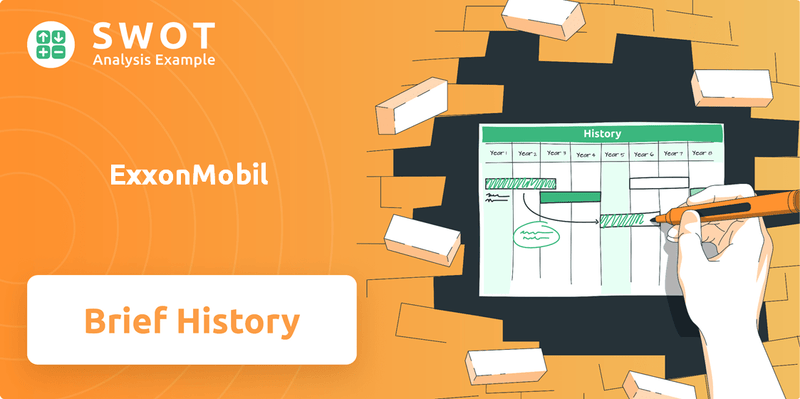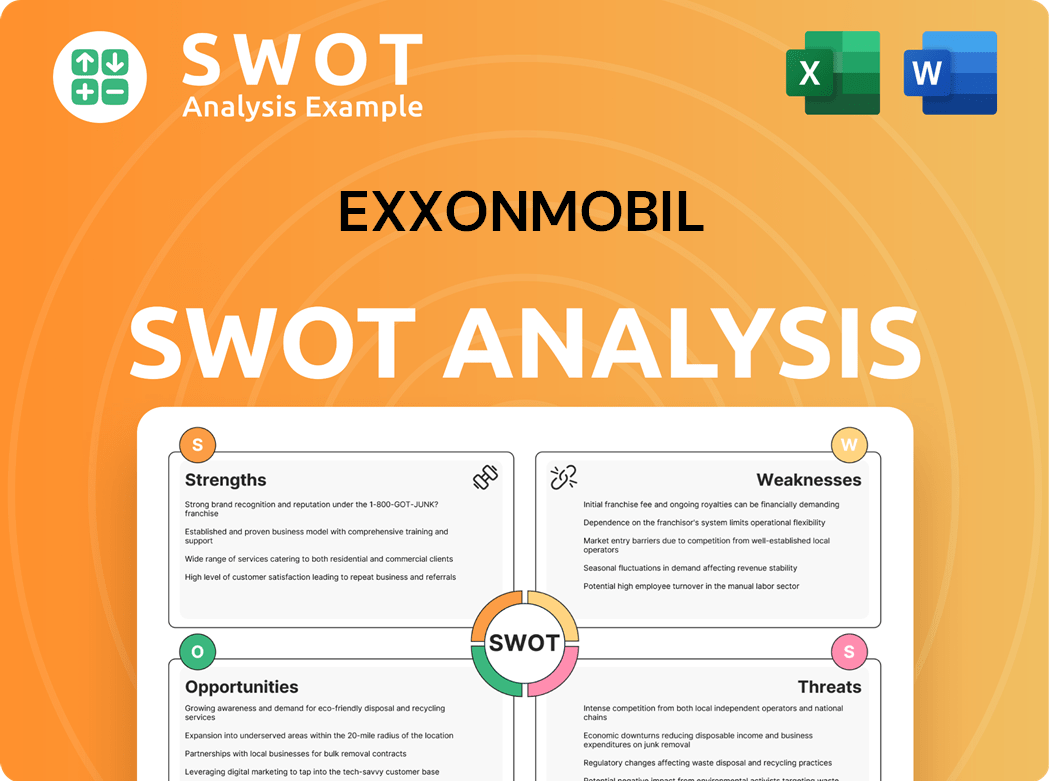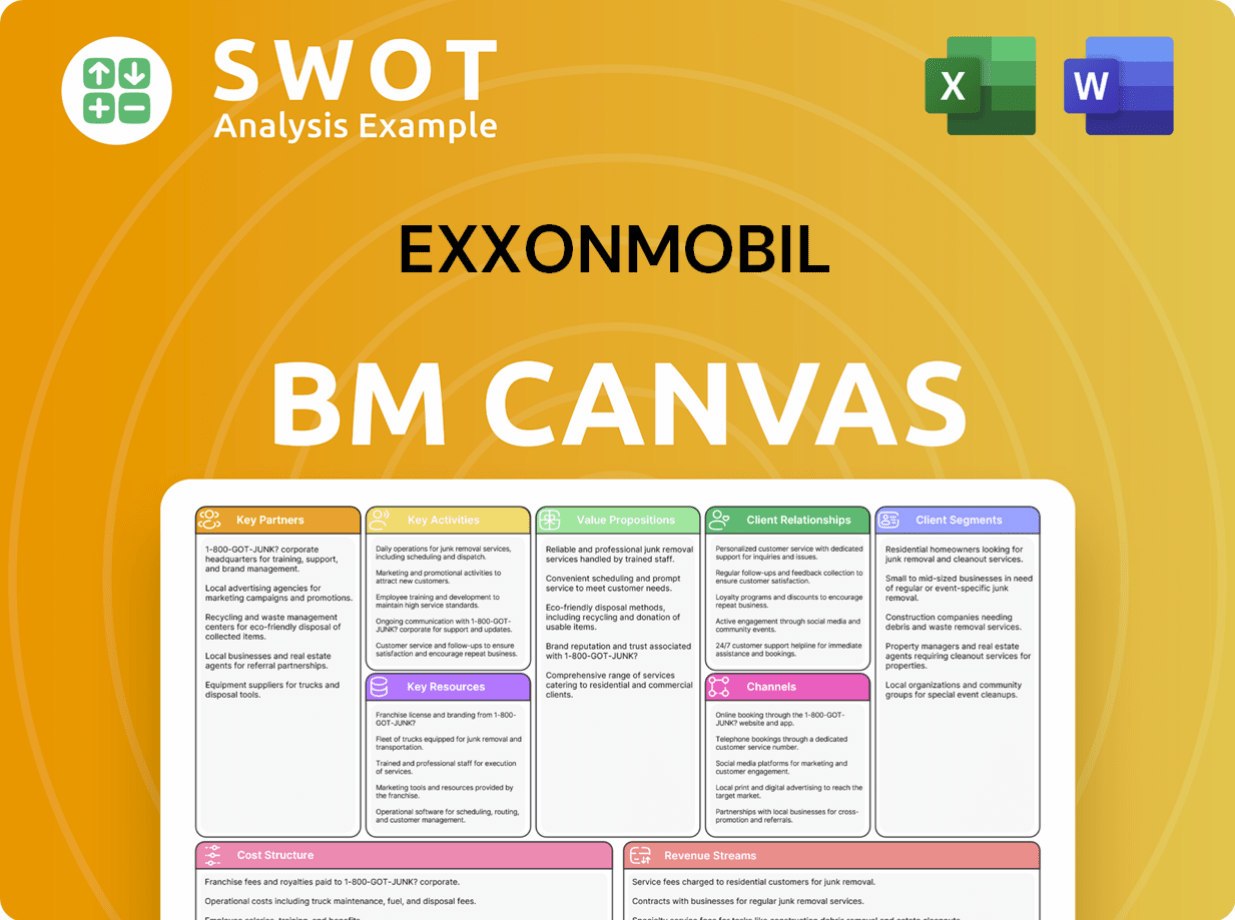ExxonMobil Bundle
How did ExxonMobil become a global energy titan?
Delve into the ExxonMobil SWOT Analysis to understand the forces behind its success. The ExxonMobil history is a compelling narrative of ambition, innovation, and adaptation, beginning with the creation of Standard Oil in 1870. This ExxonMobil company, now a global behemoth, has a rich and complex past.

From its ExxonMobil origins as a regional refiner, the company's ExxonMobil background is marked by strategic mergers, groundbreaking technological advancements, and responses to pivotal moments in history. This brief history ExxonMobil illustrates its transformation and enduring influence on the energy sector, reflecting over a century and a half of growth and change. Explore the ExxonMobil timeline to discover key milestones.
What is the ExxonMobil Founding Story?
The story of the company, now known as ExxonMobil, begins with the founding of Standard Oil. This pivotal moment occurred on January 10, 1870, in Cleveland, Ohio. The visionaries behind this venture were John D. Rockefeller, his brother William Rockefeller, Henry Flagler, Samuel Andrews, and Stephen Harkness.
John D. Rockefeller, a businessman with a background in commission merchandising, saw a massive opportunity in the oil industry. He aimed to bring order and efficiency to the refining process. The initial focus was to solve the highly competitive and often wasteful nature of oil refining, which caused unstable prices and profits.
The original business plan of Standard Oil involved acquiring and consolidating oil refineries. The company then integrated them horizontally and vertically to control the entire supply chain, from crude oil production to transportation and marketing. Their first product was refined kerosene, which was in high demand for lighting.
The name 'Standard Oil' was chosen to highlight the consistent quality of their refined products. This was a contrast to the unreliable offerings of competitors. Initial funding came from the partners themselves.
- John D. Rockefeller's attention to detail and his pursuit of efficiency were key to overcoming early challenges.
- The post-Civil War era, with its rapid industrialization and increasing energy demand, provided a strong foundation for Standard Oil's growth.
- The company's evolution is a significant part of the Owners & Shareholders of ExxonMobil.
By the late 1870s, Standard Oil controlled about 90% of the oil refining capacity in the United States. This dominance led to antitrust scrutiny. The company faced legal challenges and was eventually broken up in 1911 by the Supreme Court, resulting in the creation of several independent companies. These included companies that would later become part of the modern-day ExxonMobil.
The company's early oil exploration efforts were crucial. They expanded beyond refining to include production and transportation. This vertical integration was a key strategy for controlling costs and ensuring supply. The company's involvement in World War II was also significant. It played a vital role in supplying fuel and other petroleum products to the Allied forces. This period highlighted the strategic importance of oil.
Over time, the company made major acquisitions. These acquisitions helped expand its operations and market reach. The merger history of ExxonMobil is a story of strategic growth and adaptation. The company has responded to climate change concerns. It has invested in research and development of alternative energy sources. In 2024, ExxonMobil's current operations include exploration, production, refining, and marketing of oil and natural gas. The company's corporate structure is complex, with various divisions and subsidiaries. ExxonMobil's leadership through the years has guided its evolution and strategic decisions.
ExxonMobil SWOT Analysis
- Complete SWOT Breakdown
- Fully Customizable
- Editable in Excel & Word
- Professional Formatting
- Investor-Ready Format

What Drove the Early Growth of ExxonMobil?
The early growth of the company now known as ExxonMobil, was marked by aggressive expansion. This involved acquiring competitors and integrating operations to control the oil business from extraction to sales. This strategic approach laid the foundation for its future dominance in the energy sector. The company's early history is a story of rapid consolidation and geographical expansion.
Standard Oil's initial strategy focused on horizontal integration. By 1872, it had absorbed 22 of its 26 Cleveland competitors in a process known as the 'Cleveland Massacre.' This rapid consolidation gave the company significant control over refining capacity. This early move was crucial in establishing its market position.
Following horizontal integration, the company pursued vertical integration. This involved investing in pipelines, tank cars, and marketing infrastructure. The goal was to control every aspect of the oil business. This strategy allowed for greater efficiency and control over the supply chain.
The Standard Oil Trust was formed in 1882 to manage its vast holdings across multiple states. This structure helped the company navigate legal challenges related to monopolies. The trust allowed for centralized control and efficient management of its diverse operations.
The company expanded into new geographical markets, both domestically and internationally, establishing a global presence. Its products were well-received due to consistent quality and competitive pricing. This expansion was driven by economies of scale and operational efficiency, shaping the company's trajectory. For more insights, check out the Target Market of ExxonMobil.
ExxonMobil PESTLE Analysis
- Covers All 6 PESTLE Categories
- No Research Needed – Save Hours of Work
- Built by Experts, Trusted by Consultants
- Instant Download, Ready to Use
- 100% Editable, Fully Customizable

What are the key Milestones in ExxonMobil history?
The ExxonMobil history is marked by significant milestones that have shaped its trajectory from its origins to its current status as a global energy leader. These milestones reflect the company's adaptation to changing market conditions, technological advancements, and geopolitical events, demonstrating its resilience and strategic foresight over more than a century.
| Year | Milestone |
|---|---|
| 1870 | John D. Rockefeller founded Standard Oil, the precursor to ExxonMobil, marking the beginning of its history. |
| 1911 | The U.S. Supreme Court ordered the breakup of Standard Oil into 34 independent companies, including Standard Oil of New Jersey (later Exxon) and Standard Oil of New York (later Mobil). |
| 1970s | The oil crises of the 1970s prompted strategic shifts towards energy conservation and diversification for both Exxon and Mobil. |
| 1999 | Exxon and Mobil merged to form ExxonMobil, a move driven by the desire for greater scale and competitiveness, valued at approximately $73.7 billion. |
| 2020s | ExxonMobil increased its investment in carbon capture technologies and biofuels in response to climate change concerns. |
Throughout its history, the
Standard Oil pioneered large-scale integrated operations, setting a precedent for the modern oil industry. This model encompassed all aspects of the business, from production to distribution, enhancing control and efficiency.
The company developed new refining processes to maximize product yield, which was crucial for meeting the growing demand for petroleum products. These innovations improved the efficiency of converting crude oil into usable fuels and chemicals.
Extensive pipeline networks were developed to transport oil efficiently from production sites to refineries and distribution centers. These pipelines reduced transportation costs and improved the reliability of supply chains.
Exxon played a significant role in developing technologies for offshore drilling, enabling access to vast oil reserves located in the ocean. These technologies expanded the company's resource base and global reach.
Mobil made advancements in lubricants and chemical products, expanding its product portfolio beyond fuels. These innovations diversified the company's revenue streams and market presence.
More recently, ExxonMobil has invested in carbon capture technologies and biofuels in response to climate change concerns. These investments reflect a strategic shift towards lower-carbon energy sources.
The
The antitrust movement led to the breakup of Standard Oil in 1911, forcing a major restructuring of the company. This event transformed a monolithic entity into distinct competitors.
The oil crises of the 1970s created market volatility, necessitating strategic pivots towards energy conservation and diversification. These crises required the company to adapt to changing global energy dynamics.
ExxonMobil has faced intense environmental scrutiny, particularly regarding its impact on climate change. This has led to increased pressure to adopt sustainable practices and reduce carbon emissions.
Operating in geopolitically sensitive regions has presented challenges, including political instability and regulatory changes. These risks require careful management of operations and investments.
The growing concerns about climate change have prompted increased investment in carbon capture technologies and biofuels. This shift reflects the need to adapt to a lower-carbon future.
Fluctuating oil prices and increasing global demand have presented ongoing challenges, requiring strategic adjustments. These market dynamics demand flexibility and responsiveness from the company.
ExxonMobil Business Model Canvas
- Complete 9-Block Business Model Canvas
- Effortlessly Communicate Your Business Strategy
- Investor-Ready BMC Format
- 100% Editable and Customizable
- Clear and Structured Layout

What is the Timeline of Key Events for ExxonMobil?
The ExxonMobil history is a story of growth and transformation within the energy sector, spanning over a century. The ExxonMobil company has evolved from its ExxonMobil origins as part of the Standard Oil Trust to become one of the world's largest publicly traded international energy and petrochemical companies. This journey includes pivotal moments such as the 1999 merger of Exxon and Mobil, the company's response to global oil crises, and its current strategic shifts towards lower-emission solutions, reflecting its ExxonMobil background and its adaptation to the changing global energy landscape.
| Year | Key Event |
|---|---|
| 1870 | John D. Rockefeller and partners founded Standard Oil in Cleveland, Ohio, marking the beginning of the company's history. |
| 1882 | The Standard Oil Trust was formed, consolidating control over numerous oil companies and expanding its influence. |
| 1911 | The U.S. Supreme Court ordered the dissolution of the Standard Oil Trust, leading to the creation of 34 independent companies, including Standard Oil of New Jersey (later Exxon) and Standard Oil of New York (later Mobil). |
| 1920s-1930s | Both Standard Oil of New Jersey (Exxon) and Standard Oil of New York (Mobil) expanded internationally, establishing global refining and marketing networks. |
| 1973-1979 | Oil crises prompted significant strategic adjustments for both Exxon and Mobil, impacting their operations and strategies. |
| 1999 | Exxon and Mobil merged to form ExxonMobil, creating the world's largest oil company at the time, which is a key event in ExxonMobil's merger history. |
| 2000s | Continued global expansion, particularly in natural gas and deepwater exploration, marked a period of growth. |
| 2010s | Increased focus on unconventional resources like shale oil and gas, reflecting a shift in resource strategies. |
| 2020 | ExxonMobil announced plans for significant reductions in greenhouse gas emissions intensity, indicating a move towards sustainability. |
| 2024 | ExxonMobil is actively pursuing carbon capture and storage projects, including a significant investment in a carbon capture facility in Wyoming. |
| 2025 | As of Q1 2025, ExxonMobil continues to focus on optimizing its upstream portfolio and investing in lower-emission solutions. |
ExxonMobil's future includes substantial investments in lower-emission solutions. The company plans to invest over $20 billion in lower-carbon solutions by 2027. This includes projects in carbon capture and storage, hydrogen production, and biofuels.
Despite the push towards renewables, oil and natural gas are expected to remain crucial for decades. ExxonMobil aims to balance its traditional energy production with emerging sustainable technologies. This dual approach is key to their long-term strategy.
ExxonMobil is focused on optimizing its upstream portfolio. This involves strategic investments and leveraging its technological expertise. The company aims to navigate the energy market's complexities while addressing climate change challenges.
Understanding the competitive environment is crucial for ExxonMobil. For a deeper dive into the competitive dynamics, you can explore the Competitors Landscape of ExxonMobil, which provides valuable insights into the company's position within the industry.
ExxonMobil Porter's Five Forces Analysis
- Covers All 5 Competitive Forces in Detail
- Structured for Consultants, Students, and Founders
- 100% Editable in Microsoft Word & Excel
- Instant Digital Download – Use Immediately
- Compatible with Mac & PC – Fully Unlocked

Related Blogs
- What is Competitive Landscape of ExxonMobil Company?
- What is Growth Strategy and Future Prospects of ExxonMobil Company?
- How Does ExxonMobil Company Work?
- What is Sales and Marketing Strategy of ExxonMobil Company?
- What is Brief History of ExxonMobil Company?
- Who Owns ExxonMobil Company?
- What is Customer Demographics and Target Market of ExxonMobil Company?
Disclaimer
All information, articles, and product details provided on this website are for general informational and educational purposes only. We do not claim any ownership over, nor do we intend to infringe upon, any trademarks, copyrights, logos, brand names, or other intellectual property mentioned or depicted on this site. Such intellectual property remains the property of its respective owners, and any references here are made solely for identification or informational purposes, without implying any affiliation, endorsement, or partnership.
We make no representations or warranties, express or implied, regarding the accuracy, completeness, or suitability of any content or products presented. Nothing on this website should be construed as legal, tax, investment, financial, medical, or other professional advice. In addition, no part of this site—including articles or product references—constitutes a solicitation, recommendation, endorsement, advertisement, or offer to buy or sell any securities, franchises, or other financial instruments, particularly in jurisdictions where such activity would be unlawful.
All content is of a general nature and may not address the specific circumstances of any individual or entity. It is not a substitute for professional advice or services. Any actions you take based on the information provided here are strictly at your own risk. You accept full responsibility for any decisions or outcomes arising from your use of this website and agree to release us from any liability in connection with your use of, or reliance upon, the content or products found herein.